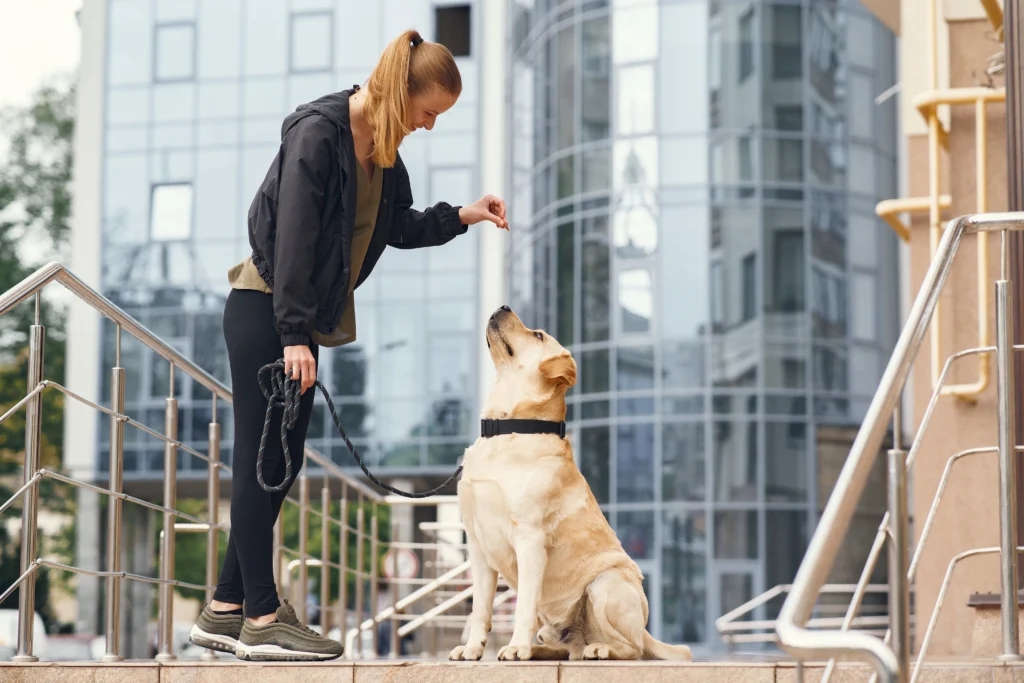Service dogs provide life-changing assistance to individuals with disabilities, offering independence, security, and companionship that transforms lives daily. The journey of service dog training requires dedication, consistency, and specialized knowledge to develop a canine partner capable of performing specific tasks with reliability and confidence. Whether you’re exploring how to train a service dog for yourself or a loved one, or considering a career in this rewarding field, understanding the fundamentals of effective service dog training is essential for success.
According to the Americans with Disabilities Act (ADA), service dogs are individually trained to perform specific tasks directly related to a person’s disability. This specialized service dog training goes far beyond basic obedience, requiring a structured approach that develops both physical skills and the unique temperament necessary for public service work.
In this comprehensive guide, we’ll explore ten proven tips for effective service dog training that can help unlock success in developing these remarkable working partnerships. From selecting the right candidate to navigating public access training, these insights draw on best practices from professional trainers and organizations dedicated to excellence in service-dog-training.
1. Start with Candidate Selection: The Foundation of Service Dog Training
The journey of successful service dog training begins before the first command is ever taught—it starts with selecting the right canine candidate. According to Assistance Dogs International, a coalition of not-for-profit assistance dog organizations, proper candidate selection can significantly impact training success rates.
Key Traits for Service Dog Candidates
When evaluating potential dogs for service-dog-training programs, experts look for specific temperamental and physical characteristics:
- Sound temperament: Calm, confident, and adaptable to new environments
- Appropriate energy level: Energetic enough to work but not hyperactive
- Social nature: Comfortable with both people and other animals
- Non-aggressive: No history of aggression toward humans or animals
- Physical soundness: Free from genetic health issues that could interfere with work
- Motivation: High food or play drive that facilitates training
- Resilience: Ability to recover quickly from startling events
Dr. Mary Burch, Director of the AKC Canine Good Citizen program, notes that temperament testing is a crucial component of candidate selection: “The best service dog training programs conduct thorough temperament evaluations before investing in a dog’s training. These assessments help identify which dogs have the natural aptitude for service work.”
Breed Considerations
While any breed or mix can potentially become a service dog, certain breeds have proven particularly successful in service dog training:
- Labrador Retrievers
- Golden Retrievers
- German Shepherds
- Standard Poodles
- Collies
- Boxers
- Mixed breeds with appropriate temperaments
The International Association of Assistance Dog Partners (IAADP) emphasizes that individual temperament matters more than breed, but choosing breeds with historical success in service dog training can increase the probability of success.
2. Establish a Strong Foundation with Obedience Training

Comprehensive service dog obedience training forms the essential foundation upon which all specialized tasks will be built. According to the American Kennel Club (AKC), mastery of basic and advanced obedience is non-negotiable for service dogs.
Core Obedience Commands
Effective service dog training begins with these fundamental commands:
- Sit, Down, Stay: The building blocks of controlled behavior
- Come: Reliable recall in all environments and circumstances
- Heel: Walking politely beside the handler without pulling
- Leave it: Ignoring distractions, food, or items on the ground
- Wait: Pausing before proceeding through doorways or into elevators
- Place: Going to a designated spot and remaining there until released
Canine behaviorist Patricia McConnell, Ph.D., emphasizes in her work that service dog obedience training must achieve a higher standard than pet dog training: “Service dogs must perform commands with near-perfect reliability in highly distracting environments. This level of obedience requires methodical training with gradual increases in distraction levels.”
Proofing Commands
Successful service dog training incorporates “proofing”—teaching the dog to respond to commands in increasingly challenging environments:
- Begin in quiet, familiar settings
- Gradually introduce minor distractions
- Practice in more challenging environments
- Work toward reliable performance in public spaces
The Psychiatric Service Dog Partners organization recommends the “Three D’s” approach to service dog training: Distance, Duration, and Distraction. By systematically increasing these variables, handlers can develop rock-solid obedience that withstands real-world challenges.
3. Focus on Task-Specific Training for Individual Needs
What truly defines service dog training is the development of specific tasks that mitigate the handler’s disability. The American Veterinary Medical Association (AVMA) emphasizes that task training is what legally distinguishes service dogs from emotional support or therapy animals.
Common Service Dog Tasks
Depending on the handler’s needs, service dog training may focus on tasks such as:
- Mobility assistance: Retrieving items, opening doors, providing balance support
- Medical alert: Detecting blood sugar changes, seizures, or allergic reactions
- Psychiatric support: Interrupting self-harming behaviors, providing pressure therapy during anxiety, creating space in crowds
- Hearing assistance: Alerting to sounds like doorbells, alarms, or a child crying
- Visual guidance: Navigating obstacles, finding exits, locating specific places
Dr. Bonnie Bergin, founder of Assistance Dog Institute (now Bergin University), pioneered many modern service dog training techniques. Her research indicates that task training should build on natural canine behaviors whenever possible to facilitate learning and reliability.
Breaking Tasks into Components
Professional service dog training programs break complex tasks into small, teachable components:
- Identify the final behavior needed
- Break it into small steps
- Teach each step separately using positive reinforcement
- Chain the behaviors together gradually
- Add verbal cues once the behavior is reliable
- Practice until the task becomes automatic
The Guide Dog Foundation notes that this methodical approach to service dog training ensures both precision and reliability in task performance—essential qualities for working service dogs.
4. Utilize Positive Reinforcement Methods
Modern service dog training overwhelmingly relies on positive reinforcement methods, which research has shown to be both more effective and more humane than punishment-based approaches. The Association of Professional Dog Trainers (APDT) strongly advocates for reward-based training for all dogs, and especially for service dogs.
Benefits of Positive Methods in Service Dog Training
According to research published in the Journal of Veterinary Behavior, positive reinforcement in service dog trainingoffers significant advantages:
- Stronger handler-dog bond
- Greater willingness to offer behaviors
- Reduced stress during training
- Better problem-solving abilities
- Lower likelihood of fear or aggression development
- Improved retention of trained behaviors
Renowned animal behaviorist Dr. Karen Overall emphasizes that service dog training based on positive methods produces more reliable working dogs who can make good decisions independently when necessary—a crucial quality for service work.
Effective Reinforcement Strategies
Professional service dog training incorporates various reinforcement techniques:
- Food rewards: High-value treats for new or challenging behaviors
- Toy rewards: Play as reinforcement for appropriate drive
- Verbal praise: Consistent markers of success
- Physical affection: Petting and attention as additional reinforcement
- Life rewards: Access to desired activities as reinforcement for good behavior
Clicker training, a precise marker-based system, is widely used in service dog training programs because it allows for exact timing of reinforcement, helping dogs understand precisely which behavior earned the reward.
5. Implement Public Access Training Strategically
Perhaps the most challenging aspect of service dog training is preparing dogs to work calmly and reliably in public environments. The United States Service Dog Registry emphasizes that public access training should be approached gradually, setting the dog up for success rather than overwhelming them.
Progressive Exposure Approach
Effective service dog training for public access follows a progressive pattern:
- Controlled environments: Begin with quiet, low-distraction public spaces
- Gradual progression: Slowly increase time, distraction levels, and complexity
- Scenario practice: Rehearse specific situations the team will regularly encounter
- Recovery training: Teach the dog to refocus after distractions or disruptions
- Duration building: Gradually extend working periods to match real-life needs
According to the International Association of Assistance Dog Partners, this methodical approach to public access service dog training helps prevent backsliding and ensures the dog develops confidence in various environments.
Public Access Standards
Proper service dog training for public work ensures dogs meet these essential standards:
- Unobtrusive behavior: Remaining quiet and calm in public
- No solicitation: Not seeking attention from strangers
- Bathroom reliability: Eliminating on command in appropriate locations
- Focused attention: Maintaining awareness of the handler despite distractions
- Social neutrality: Being polite but not overly interested in other people or animals
- Stress resilience: Recovering quickly from startling events
The Assistance Dogs International Public Access Test provides a comprehensive framework for evaluating these skills, serving as a benchmark for quality in service dog training.
6. Develop Handler Training Alongside Dog Training

Effective service dog training recognizes that success depends on two learners: the dog and the handler. The Seeing Eye, America’s oldest guide dog school, places significant emphasis on handler training as an integral component of their service dog training programs.
Handler Skills Development
Comprehensive service dog training programs teach handlers:
- Clear communication: Consistent cues and expectations
- Proper equipment use: Handling leashes, collars, and specialized gear
- Body positioning: Physical cues that support the dog’s understanding
- Public interaction: Managing encounters with the public
- Problem-solving: Addressing challenges and unexpected situations
- Reinforcement techniques: Maintaining and strengthening trained behaviors
- Legal rights: Understanding applicable service dog laws
Dr. Ádám Miklósi, a leading researcher in dog cognition and author of “Dog Behaviour, Evolution, and Cognition,” emphasizes that the handler’s skills can significantly influence service dog training outcomes: “The handler’s timing, consistency, and ability to read their dog’s subtle signals dramatically impact the success of the working partnership.”
Team Training Period
Professional service dog training programs typically include a dedicated team training period where the dog and their permanent handler learn to work together. The Guide Dogs for the Blind program includes a two-week residential training period focusing exclusively on establishing and strengthening this critical working relationship.
7. Address Specialized Needs with Targeted Programs
Different disabilities require specialized approaches to service dog training. Organizations that focus on specific disabilities often develop unique protocols to address particular needs.
PTSD Service Dog Training
PTSD service dog training incorporates specific interventions for symptoms of post-traumatic stress disorder. According to research published in the Journal of Consulting and Clinical Psychology, service dogs can be trained to perform tasks that directly mitigate PTSD symptoms:
- Interrupting anxiety or panic attacks
- Creating physical space around the handler in crowded environments
- Providing grounding through deep pressure therapy
- Performing room searches to alleviate hypervigilance
- Waking the handler from nightmares
- Reminding the handler to take medication
Organizations like K9s For Warriors have developed specialized PTSD service dog training programs with reported success rates of over 80% in reducing medication needs and improving quality of life for veterans.
Emotional Support vs. Service Training
It’s crucial to distinguish emotional support dog training from full service dog training. The U.S. Department of Justice clarifies this important distinction:
- Service dogs are individually trained to perform specific tasks related to a disability
- Emotional support animals provide comfort by their presence but aren’t trained for specific tasks
- Only service dogs have public access rights under the ADA
While emotional support dog training focuses on good manners and calm behavior, it doesn’t include the task-specific work or public access training that defines true service dog training.
8. Consider Professional Programs vs. Owner Training
Individuals seeking a service dog can pursue either professional service dog training programs or undertake owner-training with professional guidance. Each approach has distinct advantages and considerations.
Professional Service Dog Training Programs
The Guide Dog Foundation and similar organizations offer fully structured service dog training with these benefits:
- Experienced trainers: Professional knowledge and skill
- Proven methods: Established protocols with documented success
- Pre-trained skills: Dogs already trained in basic and advanced skills
- Team support: Ongoing assistance and problem-solving help
- Peer community: Connection with others using service dogs
The application process for these service dog training programs can be competitive, with waiting periods often ranging from 1-5 years depending on the organization and specific needs.
Owner-Training with Professional Support
For those choosing the owner-training route, working with professional service dog training classes or trainers specializing in service work is highly recommended. The International Association of Assistance Dog Partners suggests this approach offers:
- Personalized development: Training tailored to specific needs
- Immediate start: No waiting list for program acceptance
- Bond development: Early connection between dog and handler
- Cost control: Potentially lower financial investment
- Customization: Adapting methods to the individual dog and handler
Organizations like Service Dogs for America offer owner support programs that provide guidance while allowing handlers to conduct much of the training themselves.
9. Understand Legal Requirements and Certification Standards
The legal landscape surrounding service dog training certification is often misunderstood. According to the ADA National Network, there is no legally recognized certification or registration requirement for service dogs in the United States.
Certification vs. Training Standards
While service dog training certification isn’t legally required, many organizations offer certificates of completion that document:
- Training the dog has received
- Tasks the dog has been trained to perform
- Public access skills that have been demonstrated
- Assessment by qualified evaluators
These documents have no legal standing but may provide helpful information to housing providers, employers, or others who need to understand the dog’s role.
Minimum Training Standards
Several organizations have established recommended standards for service dog training. The Assistance Dogs International (ADI) minimum standards include:
- At least 120 hours of training over six months
- At least 30 hours of public access work in various settings
- Demonstrated ability to perform at least three tasks directly related to the handler’s disability
- Passing a public access test that evaluates behavior in public environments
While these standards aren’t legally mandated, they provide a valuable benchmark for quality in service dog training.
10. Invest in Ongoing Education and Maintenance Training

Service dog training doesn’t end when initial skills are acquired. According to Canine Companions, one of America’s largest service dog providers, ongoing education and maintenance training are essential for long-term success.
Maintenance Training Practices
Effective maintenance for service dog training includes:
- Regular practice of all trained tasks
- Ongoing public access work to maintain reliability
- Periodic “refresher” sessions for less-frequently used skills
- Gradual introduction to new environments the team might encounter
- Problem-solving for any emerging issues or challenges
The Guide Dog Foundation recommends that handlers dedicate at least 30 minutes daily to maintaining and strengthening their dog’s service dog training through practice, play, and reinforcement.
Continuing Education Resources
Handlers can benefit from continued learning through:
- Online service dog training resources from reputable organizations
- Workshops offered by service dog organizations
- Membership in handler support groups
- Consultations with professional trainers for specific issues
- Books and publications specific to service dog handling
The IAADP provides extensive continuing education resources for handlers, recognizing that service dog training is a lifelong journey rather than a one-time accomplishment.
Finding Service Dog Training Resources Near You
For many prospective handlers, the search begins with exploring service dog training near me options. Several approaches can help identify local resources:
Locating Professional Assistance
To find service dog training near me, consider:
- Assistance Dogs International’s program search to locate accredited organizations
- Veteran’s organizations for referrals to PTSD service dog training resources
- Disability-specific organizations that may recommend specialized programs
- Local chapters of national service dog organizations
- Veterinary referrals to trainers with service dog experience
The National Education for Assistance Dog Services (NEADS) offers a national program with regional training components that might be accessible regardless of location.
Evaluating Training Programs
When researching service dog training near me options, evaluate potential programs by considering:
- Trainer qualifications and experience specific to service dogs
- Training methods used (positive reinforcement preferred)
- Success rates and graduated teams you can speak with
- Program costs and what they include
- Post-graduation support services
- Accreditation with organizations like ADI
The AKC Service Dog Program provides general guidelines that can help evaluate the quality of local service dog training programs.
Service Dog Training Online: Supplemental Resources
While full service dog training cannot be accomplished entirely online, digital resources can provide valuable supplemental information. The COVID-19 pandemic accelerated the development of quality online service dog training resources from reputable organizations.
Benefits of Online Resources
Quality online service dog training can offer:
- Access to expert knowledge regardless of location
- Visual demonstrations of training techniques
- Community support through forums and groups
- Budget-friendly supplemental information
- Self-paced learning options
The Academy for Dog Trainers, founded by renowned trainer Jean Donaldson, offers online courses that can support those undertaking service dog training with professional guidance.
Limitations of Virtual Training
The International Association of Animal Behavior Consultants (IAABC) cautions that online service dog training has significant limitations:
- Inability to assess and adjust for the specific dog’s responses
- Lack of real-time feedback on handler technique
- No direct assistance with public access challenges
- Difficulty addressing unexpected training problems
- Absence of hands-on guidance for complex tasks
Most professionals recommend using online resources to supplement in-person service dog training rather than replace it entirely.
Conclusion: The Journey of Service Dog Training
The journey of service dog training represents a significant commitment of time, resources, and energy—but the results can be life-changing. A well-trained service dog can provide independence, security, and confidence to individuals with disabilities, opening doors to experiences and opportunities that might otherwise remain inaccessible.
Whether pursuing professional service dog training programs or undertaking owner training with support, the principles outlined in these ten tips provide a roadmap to success. By focusing on solid foundations, positive methods, thorough socialization, and ongoing education, handlers and their canine partners can develop working relationships that transform daily life.
As our understanding of canine cognition advances and training methods continue to evolve, the field of service dog training will undoubtedly see continued innovation. Organizations dedicated to this important work continue to refine their approaches, develop new task training, and expand the possibilities of how these remarkable dogs can assist humans with disabilities.
For those beginning this journey, connecting with experienced trainers, reputable organizations, and supportive communities can provide the guidance needed to navigate the complexities of service dog training successfully. With patience, consistency, and commitment to best practices, the goal of a reliable, confident service dog is achievable—opening the door to greater independence and an enhanced quality of life.
FAQs About Service Dog Training
Q: How long does service dog training typically take?
A: Complete service dog training generally requires 1-2 years of dedicated work. According to Assistance Dogs International, professional programs typically provide approximately 120-150 hours of training over a minimum of six months, but the full development of a service dog often takes longer. Organizations like Canine Companions report that their total service dog training investment exceeds 600 hours per dog when including puppy raising, professional training, and team training components.
Q: What’s the difference between service dogs, therapy dogs, and emotional support animals?
A: The distinction is primarily in their training and legal status. Service dog training prepares dogs to perform specific tasks that mitigate a handler’s disability, and these dogs have public access rights under the ADA. Therapy dogs receive training to provide comfort to multiple people in facilities like hospitals or schools but don’t have public access rights. Emotional support animals provide comfort by their presence but don’t require specific task training and don’t have public access rights. The American Kennel Club provides detailed explanations of these important distinctions.
Q: How much does professional service dog training cost?
A: The cost of professional service dog training programs varies widely. According to the National Service Animal Registry, fully-trained service dogs from established organizations typically cost between $15,000 and $30,000, though these costs are often offset by fundraising, grants, and donations so the handler may pay significantly less. Private service dog training with professional trainers can range from $150-$250 per hour or $12,000-$20,000 for comprehensive programs. Many nonprofit organizations provide service dogs at reduced costs or through financial aid programs for qualified applicants.
Q: Can any dog breed become a service dog?
A: Technically, any breed or mix can undergo service dog training, but certain breeds show higher success rates. According to Service Dog Certifications, Labrador Retrievers, Golden Retrievers, German Shepherds, and Standard Poodles have the highest success rates in professional programs. However, individual temperament matters more than breed, and many mixed-breed dogs excel in service dog training. The key factors are temperament, physical capability for required tasks, appropriate size for the needed work, and health clearances relevant to the breed or mix.
Q: Is owner training a service dog legally recognized?
A: Yes, the Americans with Disabilities Act (ADA) explicitly recognizes owner-trained service dogs. According to the U.S. Department of Justice Civil Rights Division, “People with disabilities have the right to train the dog themselves and are not required to use a professional service dog training program.” However, the dog must still be trained to perform specific tasks related to the disability and must behave appropriately in public. Many people pursuing owner training still seek professional guidance through service dog training classes or consultations to ensure success.









Hello,
Exclusive promo quality music for DJs https://0daymusic.org
MP3/FLAC, label, music videos. Fans giving you full access to exclusive electronic, rap, rock, trance, dance… music.
0day team.